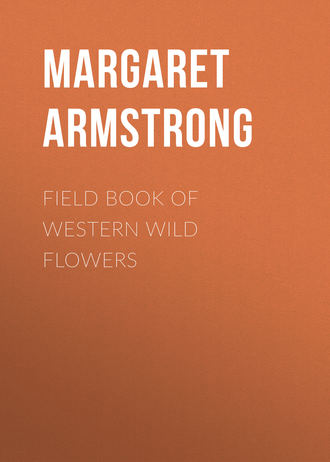 полная версия
полная версияField Book of Western Wild Flowers
Arizona Valerian
Valeriàna Arizònica
Pink
Spring
Arizona
An attractive plant, from three to nine inches tall, with smooth hollow stems, smooth leaves, and pretty clusters of flowers, but not nearly so large as the last. They are purplish-pink and slightly sweet-scented. This grows in crevices in the rocks in moist places.
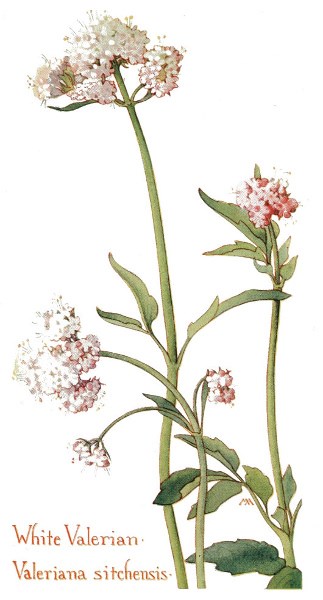
White Valerian – Valeriana sitchensis.
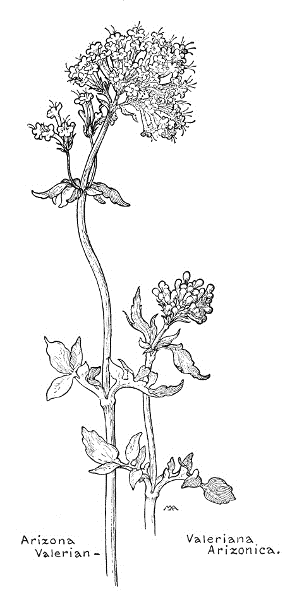
Arizona Valerian – Valeriana Arizonica.
HONEYSUCKLE FAMILY. Caprifoliaceae
Not a large family, mostly of the northern hemisphere; herbs, shrubs, shrubby vines or trees; leaves opposite, usually without stipules; flowers perfect, regular or irregular; calyx with three to five divisions; corolla usually with five united lobes, sometimes two-lipped; stamens on the corolla tube, usually as many as its lobes and alternate with them; ovary inferior, with one style; fruit a berry, stone-fruit, or capsule.
There are many kinds of Lonicera, shrubs, or twining woody vines; leaves usually without teeth or lobes, the upper ones sometimes united around the stem; flowers usually irregular; calyx with five, minute teeth; corolla more or less funnel-shaped, often two-lipped, four lobes forming the upper lip and one lobe the under, tube often swollen at base; stamens five; style with a cap-like stigma; fruit berrylike.
Orange Honeysuckle
Lonicèra ciliòsa
Orange and scarlet
Summer
Northwest
A climbing or trailing shrub, with brilliant flowers, set off by bright green leaves, thin in texture, with pale "bloom" on the under side and usually hairy margins, the lower ones with short leaf-stalks, the upper usually united and forming a disk. The flowers are scentless, about an inch and a quarter long, with smooth, trumpet-shaped corollas, bright orange at base, shading to scarlet above, with a bright green stigma and crimson or brownish anthers. This lives in the woods and sometimes climbs to the tops of quite tall trees, ornamenting them with its splendid clusters of flowers and sprinkling the forest floor with its fallen blossoms in a shower of scarlet and gold.
Black Twinberry
Lonicèra involucràta
Yellow
Spring, summer
West
A bush, from three to seven feet high, with thick, woody, pale gray stems and bright green leaves, glossy and thin in texture, or rather coarse and hairy, with fine hairs along the margins. The flower-stalks each bear a pair of flowers, without scent, emerging from an involucre of two bracts. The corolla is rather hairy and sticky, half an inch or more long, a pretty shade of warm dull yellow, sometimes tinged with red outside, with five, short, nearly equal lobes, the tube swollen at base. The involucre becomes dark red, its lobes turn back and display a pair of berries, disagreeable to the taste, as large as peas, nearly black, the whole affair striking in color and form. This grows in moist mountain woods and seems to have smoother, glossier foliage, and smaller flowers, in Utah than elsewhere.

Orange Honeysuckle – L. ciliosa.
Black Twinberry – Lonicera involucrata.
Pink Honeysuckle
Lonicèra hispídula
Pink
Summer
Wash., Oreg., Cal.
Rather pretty, with a woody trunk and hairy twigs, climbing over shrubs and trees, sometimes to a height of twenty feet. The leaves are pale on the under side, the upper ones usually united around the stem, and the flowers are about three-quarters of an inch long, with pink corollas and long stamens, and form long clusters, which are pretty but not effective, though the translucent, orange-red berries are handsome and conspicuous. This varies very much, especially in hairiness and color of the foliage, and is quite common in canyons and along streams in the Coast Ranges. The Yellow Honeysuckle, L. Califórnica, is similar, but with smooth branches and leaves and pale yellow flowers; growing in Oregon and northern California.
There are two kinds of Linnaea.
Twin-flower
Linnaèa boreàlis var. Americàna
Pink
Summer
Northwest, Utah, etc.
One of the loveliest of woodland plants; the long, woody stems trail over the ground and send up straight, slender branches, a few inches tall, clothed with leathery, evergreen leaves, bright green and glossy, and terminating in a slender, slightly hairy flower-stalk, which bears a pair of little nodding flowers, about half an inch long, hanging on very slender pedicels, with two bracts. The corollas are regular, with five lobes, delicate pink, veined with deeper color and paler at the margins, with a white pistil and four, white stamens, not protruding. The fruit is roundish and dry, with one seed. This often carpets the forest floor with its glossy foliage, ornamenting the moss with its fairy-like blossoms, which perfume the air with a fragrance like Heliotrope. It is found in cold, mountain woods, up to thirteen thousand feet, across the continent and also in Europe and Asia, and was named after Linnaeus because it was a favorite of his.
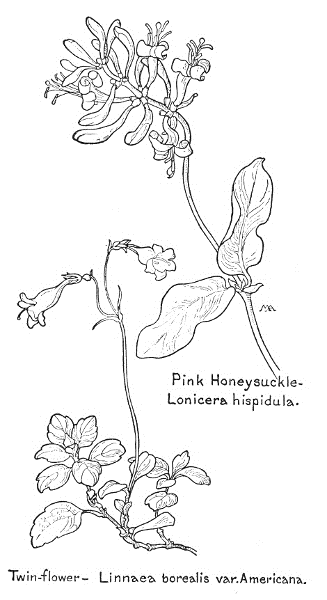
Pink Honeysuckle – Lonicera hispidula.
Twin-flower – Linnaea borealis var. Americana.
There are several kinds of Symphoricarpos, of North America and Mexico; low, branching shrubs, with small leaves, scaly leaf-buds, and small, pink or white flowers, with two bracts, in clusters; the calyx roundish, with four or five teeth; the corolla regular, more or less bell-shaped, with four or five lobes; the fruit a roundish, white or red berry, containing two bony seeds. We often find Snowberries cultivated in old-fashioned gardens.
Snowberry
Symphoricàrpos racemòsus
Pink
Spring, summer
U. S.
An attractive shrub, about four feet high, with slender branches and yellowish twigs. The pretty leaves are mostly smooth, rich green, but not glossy, paler and sometimes downy on the under side, thin, but rather crisp in texture, usually with a few shallow scallops along the margins. The flowers are about a quarter of an inch long, with bell-shaped corollas, purplish-pink outside, white and woolly in the inside, the stamens and style not protruding. The berry is large and pure-white, with white, almost tasteless pulp, which is said to be slightly poisonous. This is very common in California, in the hill country, and is found across the continent.
Snowberry
Symphoricàrpos longiflòrus
White
Summer
Arizona
A straggling shrub, from two to three feet high, with small, slightly velvety, rather pale green leaves, white on the under side, sometimes set edgewise on the stem. The flowers are about half an inch long, with a slender, white, salver-form corolla, with widely separating lobes and very smooth inside, the anthers partially protruding from the throat, and the pretty berries are waxy-white. This grows at the Grand Canyon.
Snowberry
Symphoricàrpos oreóphilus
Pink
Spring, summer
Idaho, Utah, Ariz.
A branching shrub, not especially pretty, about three feet high, with shreddy bark, pinkish twigs, and light, bluish-green, toothless leaves, usually smooth. The flowers are about half an inch long, with a tubular corolla, with short lobes, flesh-color, tinged with purplish-pink, the stamens and style not protruding and the buds purplish-pink. This grows in the mountains, up to eight or ten thousand feet.
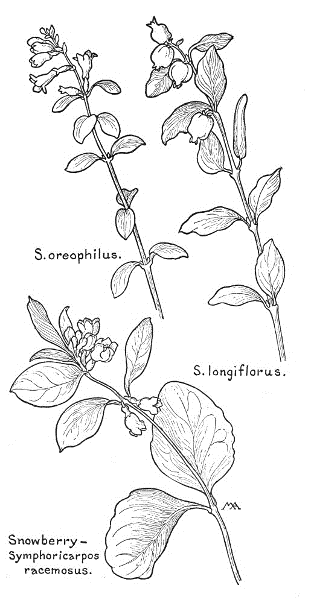
S. oreophilus.
S. longiflorus.
Snowberry – Symphoricarpos racemosus.
GOURD FAMILY. Cucurbitaceae
A large family, chiefly of the tropics, climbing or trailing, herbaceous vines, usually with tendrils, rather juicy, with no stipules; leaves alternate, with leaf-stalks, usually lobed or cut; flowers some staminate and some pistillate; calyx bell-shaped or tubular, usually five-lobed; petals mostly united, usually five, on the calyx; stamens generally three, with short filaments, often united; ovary inferior; fruit fleshy, often with a hard rind, usually with flat seeds.
There are many kinds of Micrampelis, natives of America.
Chilicothe, Wild Cucumber
Micrámpelis fabàcea (Echinocystis)
White
Summer
California
A graceful, decorative vine, with many tendrils and spreading to a great distance, sometimes as much as thirty feet, partly climbing over bushes and partly on the ground, springing from an enormous bitter root as large as a man's body, the leaves slightly rough. The pretty little flowers are half an inch across, the calyx with small teeth or with none and the corolla cream-white, with from five to seven lobes; the staminate flowers in loose clusters and the pistillate ones single. The fruit is peculiar and conspicuous, a big green ball, very prickly and measuring two inches across. The Indians used to make hair-oil out of the seeds. This is also called Big-root and Man-in-the-ground.
There are several kinds of Cucurbita, natives of America, Asia, and Africa. This is the Latin name for the Gourd.
Calabazilla, Gourd
Cucúrbita foetidíssima
Yellow
Spring
Southwest, etc.
This is a near relation of the common Pumpkin and Squash and resembles them. It is an exceedingly coarse, but very decorative vine, with bristly stems, trailing on the ground and sometimes twenty-five feet long. The leaves are about eight inches long, bluish-gray, thick and velvety, covered with bristles and exceedingly unpleasant to touch but handsome in appearance. The gaudy flowers measure five or six inches across, with a bristly calyx and bell-shaped, orange-yellow corolla. The root is enormous, sometimes six feet long, the fruit is a smooth, yellow gourd, and the whole plant has a horrible smell. This is found in dry soil, from Nebraska west, and is common in southern California.
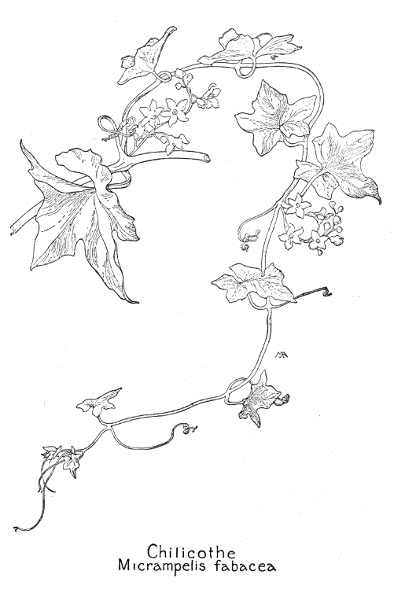
Chilicothe – Micrampelis fabacea.
BELLFLOWER FAMILY. Campanulaceae
A large family, widely distributed. Ours are small herbs, with bitter milky juice; leaves alternate, without stipules; flowers perfect, usually with five sepals; corolla with five united lobes; stamens five; ovary inferior, style long, sometimes hairy, with two to five stigmas, which do not expand until some time after the flower opens.
There are a great many kinds of Campanula; ours are chiefly perennials, with more or less bell-shaped corollas; the capsule tipped with the remains of the calyx and opening at the sides by minute holes. The name is from the Latin, meaning "little bell."
Harebell, Blue Bells of Scotland
Campánula rotundifòlia
Violet
Summer
West, etc.
This is the well-known kind, sung by the poets, and found across our continent and in Europe and Asia, reaching an altitude of twelve thousand feet. A charming, graceful little plant, with slender stems, from six inches to two feet tall, springing from a cluster of dull green, roundish or heart-shaped leaves, which usually wither away before the flowers bloom; the stem-leaves long and narrow. The flowers hang on threadlike pedicels, usually in a loose cluster, and are less than an inch long, violet or blue and paler at the base, with a long white pistil and pale yellow or lilac anthers. Neither the plants nor the flowers are nearly so fragile as they look, for the stems are wiry and the flowers are slightly papery in texture. This plant is variable and may include more than one kind. It seems hardly necessary to remark that it is not to be confused with Calochortus albus, which is unfortunately sometimes called Hairbell and is entirely different, but I have several times been asked whether they were the same.
Bellflower
Campánula Scoúleri
White, lilac
Summer
Northwest, Cal.
A pretty little plant, with smooth, slender stems, from six to eight inches tall, and smooth, toothed leaves. The flowers are in a loose cluster and are more the shape of little Lilies than of Blue Bells, white tinged with lilac, or pale blue, with yellow anthers and a long pistil with three pink stigmas. The California Harebell, C. prenanthoìdes, has blue flowers, similar in shape.
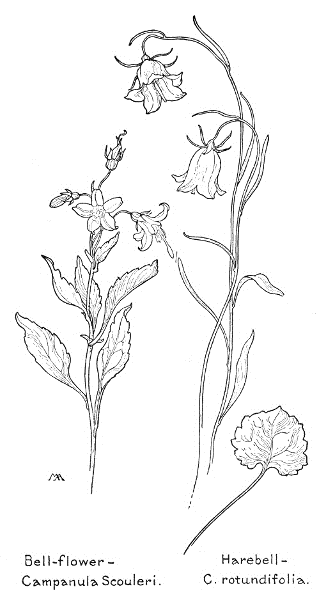
Bell-flower – Campanula Scouleri.
Harebell – C. rotundifolia.
SUNFLOWER FAMILY. Compositae
The youngest and largest plant family, comprising about seven hundred and fifty genera and ten thousand species, highly specialized for insect pollination, easily recognized as a whole, but many of its members difficult to distinguish. Some tropical kinds are trees; ours are usually herbs, sometimes shrubs, without stipules; the leaves opposite, alternate or from the root; the flowers all small and crowded in heads, on the enlarged top of the flower-stalk, which is called the "receptacle," and surrounded by a common involucre of separate bracts, few or many, arranged in one or more rows; the receptacle also sometimes having scale-like or bristle-like bracts among the flowers, its surface smooth, or variously pitted and honey-combed. The flowers are sometimes perfect, or with only pistils, or only stamens, or with stamens and pistils on different plants, or all kinds mixed. The calyx-tube is sometimes a mere ring, or its margin consists of hairs, bristles or scales, called the "pappus." The corollas are chiefly of two sorts; they are tubular and usually have five lobes or teeth, but often the flowers around the margin of the head are strap-shaped, that is, the border of the corolla is expanded into what is called a "ray." For instance, the yellow center, or "disk," of a Daisy is composed of a crowded mass of tiny tube-shaped flowers, which is surrounded by a circle of white, strap-shaped flowers, or rays, which look like petals. A Thistle, on the other hand, has no rays and the head is made up of tube-shaped flowers only. Stamens usually five, on the corolla-tube, alternate with its lobes, anthers usually united into a tube surrounding the style, which has two branches in fertile flowers, but usually undivided in sterile flowers; ovary inferior, one-celled, maturing into an akene, often tipped with hairs from the pappus to waft it about, or with hooks or barbs to catch in fur of animals. (Descriptions of genera have been omitted as too technical.)
There are many kinds of Carduus (Cnicus) (Cirsium), widely distributed; with tubular flowers only.
Thistle
Càrduus Còulteri
Pink, crimson
Spring, summer
California
A strikingly handsome, branching plant, from three to seven feet high, with light green leaves, very decorative in form, more or less downy on the upper side and pale with down on the under. The flower-heads, about two inches long, have bright lilac-pink or crimson flowers and more or less woolly involucres. This grows in the hills and mountains of the Coast Ranges.
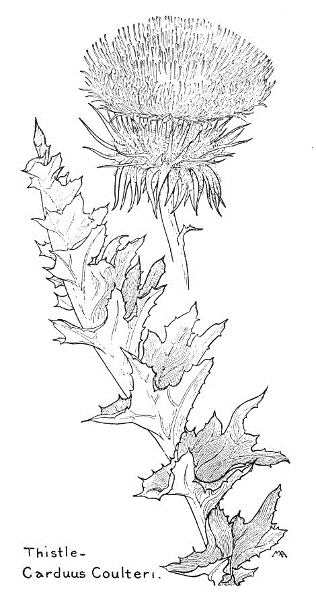
Thistle – Carduus Coulteri.
Arizona Thistle
Càrduus Arizònicus
Pink
SummerArizona
A very striking and decorative plant, both in form and color, from two to six feet tall, with a pale, branching, leafy stem, covered with close, white down, springing from a cluster of large root-leaves. The leaves are gray-green, covered with white down, and show great beauty of design, being sharply and symmetrically lobed and toothed, the margins armed with long yellow prickles. The flower-heads are an inch and a half long, with beautiful carmine and pale-pink flowers, all with no tinge of purple, the vivid spots of color giving a very brilliant effect in contrast with the pale foliage. This grows in the Grand Canyon and is conspicuous along the Berry trail, a little way below the rim.
Thistle
Càrduus candadíssimus
Pink, crimson
Summer
California
A very handsome and decorative plant, about three feet tall, with spreading stems, covered with white down, and dull-green leaves, pale with down on the under side and often covered with white down all over. The handsome flower-heads are two inches or more long and have deep pink or crimson flowers and very woolly involucres.
California Thistle
Càrduus Califórnicus
White
Spring
California
A branching plant, from two to six feet tall, very leafy below, with very dark bluish-green leaves, with more or less woolly down on the upper side and pale with matted down on the under side. The flower-heads are nearly three inches across, with cream-white or rarely purple flowers, and the bracts are caught together with silky, cobwebby down. This is common in the Sierra Nevada.
Western Thistle
Càrduus occidentàlis
Red, purple
Spring
Cal., Oreg.
A stout plant, two or three feet high, with large prickly leaves, and more or less covered all over with cottony wool. The flower-head is about two inches long, and nearly as wide, and is a ball of white, cobwebby wool, pierced all over with brown spines, and tipped with wine-colored flowers. This is common on sandy hills, near the coast, from San Francisco south. Yellow-spined Thistle, C. ochrocéntrus, found in Nevada and Arizona and as far east as Colorado, has purple flowers and leaves deeply slashed and armed with long yellow spines. This grows at the Grand Canyon.
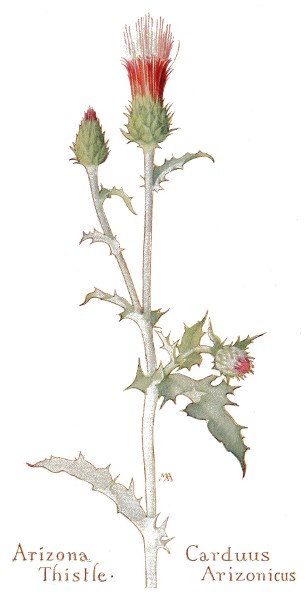
Arizona Thistle – Carduus Arizonicus.
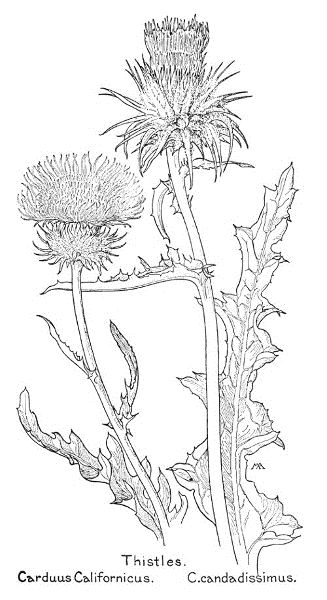
Thistles.
Carduus Californicus.
C. candadissimus.
There are a good many kinds of Anaphalis, natives of the north temperate zone, but only one in North America.
Pearly Everlasting
Anáphalis margaritàcea
White
Summer
U. S., etc.
This is the prettiest of the Everlastings, from one to three feet tall, with a leafy stem, covered with white wool, and alternate, toothless leaves, which are rather long and narrow, gray-green and more or less woolly on the upper side, pale and woolly on the under. The flower-heads are numerous, forming close, roundish clusters. The heads are without rays, but the tiny, yellow, tubular flowers are surrounded by many small, white, papery bracts, resembling petals, making the involucre the conspicuous feature and forming a pretty little, round, white head. This is common in dry places, East and West, and found in Asia. There is a picture in Mathews' Field Book. Rosy Everlasting, Antennària ròsea, has the same general appearance, but the bracts are pink, giving a pretty pink tint to the flower-cluster, and is found in the Northwest at high altitudes. Another kind of Everlasting is Gnaphàlium microcéphalum, Cudweed, a mountain plant of the Northwest and California, with similar foliage, but with larger, looser clusters of cream-white flowers, conspicuous at a distance, though not pretty close by. There is a picture of a similar species in Mathews' Field Book.
There are several kinds of Encelia.
Encelia
Encèlia eriocéphala
Yellow
Spring
Southwest
A handsome, desert plant, with rough, purplish stems, a foot and a half tall, dull-green, hairy leaves, and flowers over an inch across, in loose clusters, with bright golden-yellow rays, yellow centers, and woolly involucres. This makes fine conspicuous clumps of bright color on the pale desert sand.
Golden Hills, Brittle-bush
Encèlia farinòsa
Yellow
Spring
Arizona
A conspicuous shrubby plant, from two to four feet high, with many stout, branching stems, grayish, downy twigs, and large clumps of downy, gray-green leaves, from which spring the long, slender flower-stalks, bearing loose clusters of handsome flowers. They are each over an inch and a quarter across, with bright yellow rays and orange centers and are well set off by the rather pale foliage. This grows on hillsides among the rocks and gives a golden hue which may be seen at a distance of seven or eight miles.
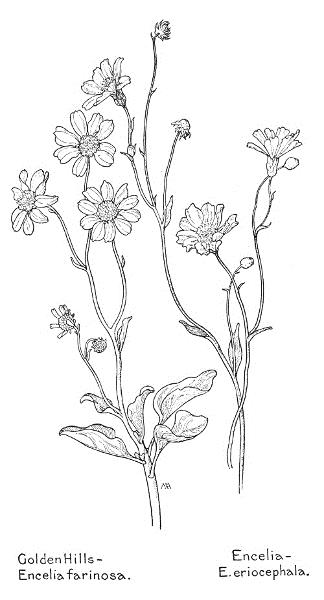
Golden Hills – Encelia farinosa.
Encelia – E. eriocephala.
California Encelia
Encèlia Califórnica
Yellow
Spring
California
A handsome conspicuous shrub, two feet or more high, gray and downy when young but becoming smoother and greener, with downy, reddish twigs, dark green leaves, and numerous flowers, on long flower-stalks. They are two or three inches across, with three-toothed, bright yellow rays and very dark maroon or brown centers, specked with yellow, and velvety or hairy involucres. This grows on sea-cliffs, where it makes very effective masses of color, in fine contrast to the blue of the sea below and the sky above.
Encèlia frutéscens
Yellow
Spring
Southwest
A rather straggling shrub, about two feet high, with whitish, woody stems, pale reddish twigs, and bright green leaves, which are roughened with minute prickles on the margins and under sides, but look quite shiny. The flower-heads are over half an inch long, in western Arizona usually without any rays, and are not especially pretty, like a starved Sunflower whose rays have shrivelled away in the dry heat of the desert, but the effect of the foliage, which suggests little apple leaves, is decidedly attractive in the arid sandy places it frequents.
There are many kinds of Helianthus, natives of the New World.
Common Sunflower
Heliánthus ánnuus
Yellow
Summer
West, etc.
A handsome kind, with a rough stem, from two to ten feet tall, roughish leaves, more or less toothed, the upper alternate, the lower opposite, and a flower-head from two to four inches across, with bright golden-yellow, toothless rays, a maroon center, and a very dark green involucre, with stiff, overlapping bracts. This is larger in cultivation and is a very useful plant, for its flowers yield honey and a yellow dye, its seeds oil and food, the leaves are good for fodder, and the stalks for textile fiber. It is common nearly everywhere along roadsides, as far east as Missouri, and is found as a stray in the East.

